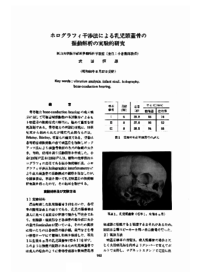

Journal of Okayama Medical Association
Published by Okayama Medical Association<Availability>
Full-text articles are available 3 years after publication.
Permalink : http://escholarship.lib.okayama-u.ac.jp/16230
Experimental study on vibration analysis of the Infant skull by Holographic interferometry
Takeda, Tsuneo
Published Date
1985-12-30
Abstract
Vibratory mode of the infant skull was observed and analysed by holography to elucidate the mechanism of bone-conduction hearing in the childhood. Three dried human infant skulls, one of six months, two of eight months postnatal age, were used. As the cranial suture was incomplete with the wide fonticulus remaining and the composition was not so dense or strong as that of the adult, very careful manipulation was needed in the experiment with the infant skull. Consequently, an acoustic loud-speaker was utilized to make the infant skull vibrate in the free sound field, instead of using direct vibrator conventionally attached to the adult skull for the measurement of vibration. An area around the foramen occipitale magnum was fixed by means of bolts, and the skull was stood on a table. Attempts were made to change the frequency and intensity of the test sounds during the experiment. The sound pressure level of the sound field was measured with a noise meter. The value measured at the site of the skull closest to the loud-speaker was regarded as the intensity of the test sound. The resulting pattern of vibration was recorded and reconstructed by holographic interferometry. As the light source for holography helium-neon laser was used.
Interference fringes were observed at 110 phon or more of the intensities of the test sounds. When frequency of the test tone was low such that 500 Hz or less, interference fringes of parallel lines were observed in the hologram. This meant the skull was found to vibrate as a whole, and the sound signal seemed to be transmitted by "inertia bone-conduction" in the mechanism of hearing when the frequency of the test sound was 500 Hz or less. on the other hand, at 1 kHz and more of the test frequency, the vibratory pattern changed into concentric fringes with multiple maximum points of amplitude. Then, it was clarified that when the frequency was 1 KHz or more, "compression bone-conduction" was added up in the hearing mechanism. At about 3 KHz of test sound, the vibratory amplitude was larger than any other frequencies used, suggesting that 3 KHz was the closest to the resonance frequency of the infant skull.
Keywords
vibration analysis
infant skull
holography
bone-conduction hearing
ISSN
0030-1558
NCID
AN00032489
